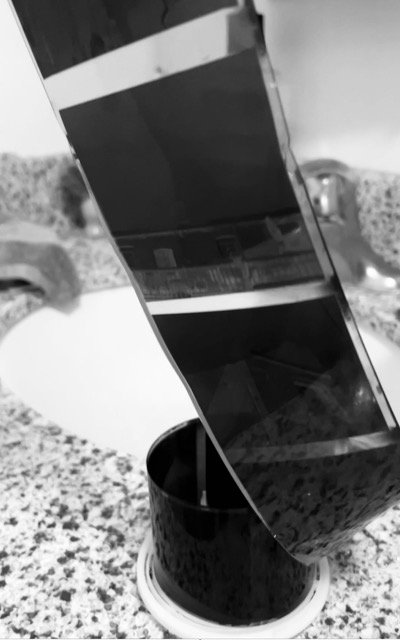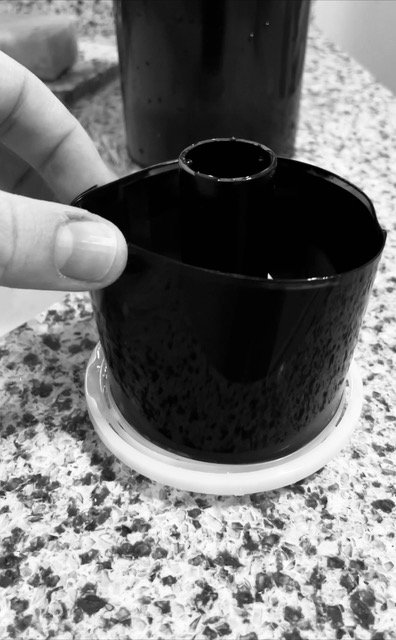The Hand
Slavek Pytraczyk
“People always get unnatural when they notice you’re taking their photograph.”
Interview by C. VanWinkle
November 22, 2022
Let's start at the beginning. Can you tell me about the prompt that I sent you?
t was a two-dimensional piece of artwork with a cutout of a hand and had words like “life” and “head” written on the fingers. Something along those lines. And some symbols painted onto the hand that I think were related to Zodiac signs, but I'm no expert in that stuff. Tarot cards and Zodiac was the were the first thoughts that came to me. But yeah, that's the image.
It was a tough image for me to work from because I thought it would be somehow linked to my art practice. I mean there's so many different things that could have been, but I thought Tarot or Zodiac or palm reading or astrology? This is totally not in my knowledge base. I know almost nothing about those things, so I decided to focus on just the hand. I could have researched a little bit about those subjects, but I thought I'd keep it simple and just work with the image of a human hand.
It all depends on your process. How did you get started?
I thought about it for a few days because it really did stump me. But I had a feeling that Bait/Switch was pretty open to just going with the flow of whatever artists you work with. I knew you'd be accepting of whatever I came up with.
I have a couple of jobs, so it's not as if I'm just a full-time artist, and I had a limited amount of time to do this. I was in the middle of a roll of black-and-white film, so why not try to finish off that roll? So it came from there. I had six or seven pictures left on a 12-frame, medium format roll of film… might as well just use that up.
Sure. And that’s your hand, right?
Yeah! I wondered, should I get a hand model? Maybe I should get one of my friends to do the hand. But no, I might as well just do it. I'll just take a photo of my own hand.
Does this count as a self-portrait?
Probably not this time. I've often thought that all of my artworks, or any artists’ works, could be considered self-portraits in a sense. Everything you make.
Oh sure. It’s your body of work, right? So then you, what, walked around your neighborhood?
And it’s been super cold out the last few days. I just picked up film photography this last spring and I’m messing around with multiple exposures at the moment. I don't know what I'm doing, but there's a lot of fun in it. A lot of trial and error. And so that's what I did, I went around the neighborhood. I'm not even sure if the camera I used worked properly, because it was so cold out. I know that shutter speeds often work very slowly if the temperature is below freezing. Now that I’ve handed in the artwork, I think that blurriness in it could have been unintentional. I put the camera on infinite focus, which makes it almost impossible to get a blurry image in the middle of the day like that. I don’t know where else that blurriness could have come from.
That camera looks old! Is it an antique?
Not quite an antique. It's actually not as old as it looks. I believe they made those models up to the 1990s. There have been a few iterations of it, starting from the 60s, but this is the third version of that camera. It is from the USSR. Strangely, I bought it from Ukraine. I’d never bought anything from eBay before and I got this from a seller specializing in cameras that lives in Rivne, Ukraine. But hey, as a feather in my cap, I'm supporting someone who’s probably not dealing with a best-case scenario right now. Anyway, it's a Twin Lens Reflex (TLR) camera. It looks old, but it's not super old.
I assumed it was from the 1970s or something. But I don’t know cameras.
I guess not much changed over 30 years.
How was working with it?
To be honest, it’s pretty frustrating so far. It's one of these cameras that you have to hold at your waist, and you look down. There's no automatic focus, so you have to look through this tiny, half-inch mirror that pops out, hopefully telling you whether you're in focus. Plus, it doesn't have an internal light meter, which means I have to have a light meter or an app. The cold weather doesn’t help either! It’s super slow, but I'm hoping to get some use out of it when the spring and summer arrive for some street photography. I think people are less suspicious of you taking photos of them when you're looking down at your camera. You're actually taking their portrait, but it doesn't look as if that’s what happening.
Oh I can imagine. Taking photos in public with people around would look a lot less invasive if you’re not holding a camera in front of your face.
Exactly. People always walk away or turn around. People always get unnatural when they notice you're taking their photograph.
I know I do! How did you decide what to take pictures of once you went outside?
I wanted you to have a quick sense of what the environment was like. I’d wondered, “What the heck am I gonna shoot in the cold in Canada?” I mainly take my images from architecture, but I don't want to make boring, just straightforward architecture photographs. So I decided I'm going to create a lot of textures and abstracted forms. I’ll take photos of puddles and a lot of snowbanks, and double or triple expose them with images of architecture. And hopefully get something interesting.
I realized that when I'm taking multiple exposures of photographs, if you work with something that’s organic alongside something that's manmade, they tend to blend well together. In the summertime, I was pairing a lot of leaves and floral images with structures and they blend in so well. I'm hoping to get that same sort of thing happening with snow and water and puddles and things like that with the buildings as well.
I'm also excited to see what happens next! How does this piece relate to the rest of your work?
I think it could spark a new direction. I usually don't have any human figures in my photographs or in my artwork. I think that’s an avenue I can definitely take, given the fact that it seemed to work out this time. By the way, that was not the only image I took of my hand. I couldn’t just take one photograph of my hand and then develop the whole roll and realize, “Oh my God, that didn't work out!” So there were multiple images. This one just happened to work out the best.
It still relates to my work by just experimenting with double and triple exposures. And the fact that I'm still documenting architecture. That's definitely the immediate way it still resonates with my current work, but I also see a possible future side project that’s a series with people or something along those lines.
If you end up doing more of that, we would certainly love to see images and hear about it. We love it when people make things with us and then take that work further afterward. Did you enjoy working from a prompt? Some find it freeing and some find it limiting.
Yeah, it didn't limit me. It challenged me. I didn't want to make a one-off and then just turn my head and keep going in the same direction. I wanted to make something that would still look like my stuff. But also, this is exactly the thing that I need from time to time. I think artists in general, from time to time, need to get some new eyes, a new perspective, whether that’s by talking to new people, going to an art gallery, meeting new artists. Often, someone will say something or you'll see something new, and it inspires you to go in a different direction or think about something that you've never thought of before. And that's what this project has done for me. I never thought I would ever do anything with human figures in my artwork, but I can see that becoming something I may do in the future.
Especially now that you’re modeling.
[laughs] Exactly! I’m a model now! I’ll put it on my CV.
Call Number: C84VA | C86VA.pyHa
Slavek Pytraczyk: Born in Bielsko-Biała, Poland and living in Mohkinstsis, Calgary, Alberta. A graduate from the Alberta University of the Arts, I photograph architecture and public spaces often showcasing themes of change and impermanence. By creating works that come from these photographs, I attempt to draw attention to these spaces by combining the images symbolically with personal and formal elements.










